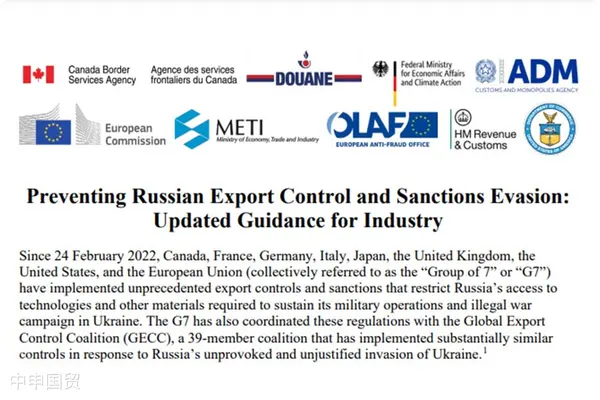G7正式發布《防止俄羅斯規避出口管制和制裁的行業指導文件》
Category: Trade ComplianceDate: On September 24th, local time, the Group of Seven (G7) officially released the Industry Guidance Document on Preventing Russia from Evading Export Controls and Sanctions (Note:

, hereinafter referred to as the Guidance or Industry Guidance), claiming that it aims to help enterprises identify and respond to Russias evasion of sanctions. Specifically targeting Russias evasion of export controls, it further clarifies the red flag indicators and high - risk item list that enterprises should pay attention to during the export process. The following is a summary of the document content:Preventing Russian Export Control and Sanctions Evasion: Updated Guidance for IndustryBackground information
Since February 24, 2022, Canada, France, Germany, Italy, Japan, the UK, the US, and the EU (collectively referred to as G7) have imposed unprecedented export controls and sanctions on Russia. These measures aim to restrict Russias access to technologies and materials for military operations, weaken its economy, and curb Russias ability to purchase Western technologies.Coordination mechanism
G7In February 2023, G7 announced the establishment of an enforcement coordination mechanism to strengthen the implementation of multilateral export controls and sanctions. In September 2023, an export control enforcement sub - working group was set up under this mechanism, mainly through means such as information sharing and discussion of best practices to help countries better respond to Russias evasion of sanctions.The Guidance provides industry with recommendations to prevent controlled items from being diverted to Russia through third - party countries. Its content includes:
Update of the high - risk item list;
Red flag indicators for export control and sanction evasion;
Best practices for the industry to respond to these red flags;
Screening tools and resources to assist in due diligence.
Russias evasion behavior
Russia has used various deceptive means to bypass the established export controls and sanctions, including transshipment of technologies and controlled items through third - party countries. All parties in the supply chain (such as exporters, re - exporters, manufacturers, distributors, financial institutions, logistics companies, etc.) need to be aware of this risk and take measures to avoid it.High - priority list
G7 countries have identified a Common High - Priority List (CHPL) containing 50 key items that Russia is trying to obtain. The industry should conduct necessary due diligence on these items to prevent their diversion to Russia.The High - Priority List (CHPL) was jointly developed by the EU, Japan, the UK, and the US, aiming to help the industry identify key items sought by Russia for its war efforts. These items are extracted from Russian - made weapons found on the battlefield or are considered important components of Russian - made military equipment.
The Critical High - Priority List (CHPL) is jointly developed by the EU, Japan, the UK, and the US. It aims to help the industry identify key items sought by Russia for its war efforts. These items are extracted from Russian - made weapons found on the battlefield or are considered important components of Russian - made military equipment.
CHPL 中的物品通過6位數的Harmonized System Code (HS Code)Identification. These codes are widely used by exporters, carriers, and freight forwarders globally to standardize the classification of goods. The purpose of the CHPL is to assist the industry in conducting due diligence and preventing the illegal diversion of these items to Russia.
The purpose of the CHPL is to help the industry identify these highly sensitive items so that necessary risk assessment and due diligence can be carried out during the export process. G7 countries use this list to ensure that enterprises can avoid their technology being used in Russias military activities during the export process.
Red flag indicators: The guidelines list a series of potential red flag indicators, alerting the industry to be vigilant about possible circumvention behaviors during exports, such as new customers suddenly importing a large quantity of controlled items, using false declarations, abnormal cargo transportation routes, etc.
G7列出了多個“紅旗”指標,幫助行業識別潛在的出口管制和制裁規避行為。在出口前,企業應使用這些指標進行盡職調查,并對其他可能的警示跡象保持警惕。這些“紅旗”可能表明交易涉及俄羅斯的規避行為,尤其是在第三國的參與下。
Additional resources: Lists a number of export control and sanctions - related tools of international organizations and countries for enterprises to refer to during due diligence and compliance processes. These resources mainly help the industry better understand and comply with the sanctions regulations of various countries and provide screening tools for specific trading parties and items.
CanadaList of restricted items and technologies
Screening Tools: The following provides links to screening tools related to export controls and sanctions in various countries, which are used to query sanction lists and review information of export trading parties:
Canada:Canadian Autonomous Sanctions List
European Union:EU Sanctions List
The UK:UK Sanctions List
United States:US Comprehensive ScreeningList
Facing the increasingly strict international trade control, ensuring compliance is the cornerstone of a companys success. Whether it is the risk assessment of export - controlled items or the identification of red flags during the transaction process, companies must strengthen their risk management capabilities to ensure the smooth and safe conduct of their businesses.
Full text of the original document:g7-updated-guidance-industry-preventing-russian-export-control-and-sanctions (bis.gov)
? 2025. All Rights Reserved. 滬ICP備2023007705號-2  PSB Record: Shanghai No.31011502009912
PSB Record: Shanghai No.31011502009912